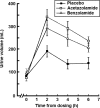Benzolamide improves oxygenation and reduces acute mountain sickness during a high-altitude trek and has fewer side effects than acetazolamide at sea level
- PMID: 27433337
- PMCID: PMC4876137
- DOI: 10.1002/prp2.203
Benzolamide improves oxygenation and reduces acute mountain sickness during a high-altitude trek and has fewer side effects than acetazolamide at sea level
Abstract
Acetazolamide is the standard carbonic anhydrase (CA) inhibitor used for acute mountain sickness (AMS), however some of its undesirable effects are related to intracellular penetrance into many tissues, including across the blood-brain barrier. Benzolamide is a much more hydrophilic inhibitor, which nonetheless retains a strong renal action to engender a metabolic acidosis and ventilatory stimulus that improves oxygenation at high altitude and reduces AMS. We tested the effectiveness of benzolamide versus placebo in a first field study of the drug as prophylaxis for AMS during an ascent to the Everest Base Camp (5340 m). In two other studies performed at sea level to test side effect differences between acetazolamide and benzolamide, we assessed physiological actions and psychomotor side effects of two doses of acetazolamide (250 and 1000 mg) in one group of healthy subjects and in another group compared acetazolamide (500 mg), benzolamide (200 mg) and lorazepam (2 mg) as an active comparator for central nervous system (CNS) effects. At high altitude, benzolamide-treated subjects maintained better arterial oxygenation at all altitudes (3-6% higher at all altitudes above 4200 m) than placebo-treated subjects and reduced AMS severity by roughly 50%. We found benzolamide had fewer side effects, some of which are symptoms of AMS, than any of the acetazolamide doses in Studies 1 and 2, but equal physiological effects on renal function. The psychomotor side effects of acetazolamide were dose dependent. We conclude that benzolamide is very effective for AMS prophylaxis. With its lesser CNS effects, benzolamide may be superior to acetazolamide, in part, because some of the side effects of acetazolamide may contribute to and be mistaken for AMS.
Keywords: Acetazolamide; acute mountain sickness; benzolamide; carbonic anhydrase inhibitor; high altitude; lorazepam; oxygen saturation; side effects.
Figures





Similar articles
-
Effects of acetazolamide on pulmonary artery pressure and prevention of high-altitude pulmonary edema after rapid active ascent to 4,559 m.J Appl Physiol (1985). 2022 Jun 1;132(6):1361-1369. doi: 10.1152/japplphysiol.00806.2021. Epub 2022 May 5. J Appl Physiol (1985). 2022. PMID: 35511718 Clinical Trial.
-
Altitude, Acute Mountain Sickness, and Acetazolamide: Recommendations for Rapid Ascent.High Alt Med Biol. 2021 Mar;22(1):5-13. doi: 10.1089/ham.2019.0123. Epub 2020 Sep 23. High Alt Med Biol. 2021. PMID: 32975448
-
Findings of Cognitive Impairment at High Altitude: Relationships to Acetazolamide Use and Acute Mountain Sickness.High Alt Med Biol. 2017 Jun;18(2):121-127. doi: 10.1089/ham.2016.0001. Epub 2017 May 16. High Alt Med Biol. 2017. PMID: 28509579
-
Efficacy of Acetazolamide for the Prophylaxis of Acute Mountain Sickness: A Systematic Review, Meta-Analysis and Trial Sequential Analysis of Randomized Clinical Trials.Am J Med Sci. 2021 May;361(5):635-645. doi: 10.1016/j.amjms.2020.12.022. Epub 2021 Feb 12. Am J Med Sci. 2021. PMID: 33587912
-
Mechanisms of action of acetazolamide in the prophylaxis and treatment of acute mountain sickness.J Appl Physiol (1985). 2007 Apr;102(4):1313-22. doi: 10.1152/japplphysiol.01572.2005. Epub 2006 Oct 5. J Appl Physiol (1985). 2007. PMID: 17023566 Review.
Cited by
-
Compound Danshen Dripping Pill inhibits high altitude-induced hypoxic damage by suppressing oxidative stress and inflammatory responses.Pharm Biol. 2021 Dec;59(1):1585-1593. doi: 10.1080/13880209.2021.1998139. Pharm Biol. 2021. PMID: 34808069 Free PMC article.
-
Prophylaxis of ibuprofen in acute mountain sickness: A protocol for systematic review and meta-analysis.Medicine (Baltimore). 2020 Nov 13;99(46):e23233. doi: 10.1097/MD.0000000000023233. Medicine (Baltimore). 2020. PMID: 33181710 Free PMC article.
-
Visuomotor performance at high altitude in COPD patients. Randomized placebo-controlled trial of acetazolamide.Front Physiol. 2022 Sep 8;13:980755. doi: 10.3389/fphys.2022.980755. eCollection 2022. Front Physiol. 2022. PMID: 36160864 Free PMC article.
-
Effect of ubiquinol on cardiorespiratory fitness during high-altitude acclimatization and de-acclimatization in healthy adults: the Shigatse CARdiorespiratory fitness study design.Front Cardiovasc Med. 2023 Jul 25;10:1129144. doi: 10.3389/fcvm.2023.1129144. eCollection 2023. Front Cardiovasc Med. 2023. PMID: 37560117 Free PMC article.
-
Dr Annmarie Hedges-an appreciation.Br J Clin Pharmacol. 2018 Jun;84(6):1393-1394. doi: 10.1111/bcp.13572. Epub 2018 Mar 22. Br J Clin Pharmacol. 2018. PMID: 29569288 Free PMC article. No abstract available.
References
-
- Bärtsch P, Swenson ER (2013). Clinical practice: acute high altitude illnesses. N Engl J Med 368: 2294–3027. - PubMed
-
- Basnyat B, Gertsch JH, Johnson EW, Castro‐Marin F, Inoue Y, Yeh C (2003). Efficacy of low‐dose acetazolamide (125 mg BID) for the prophylaxis of acute mountain sickness: a prospective, double‐blind, randomized, placebo‐controlled trial. High Alt Med Biol 4: 45–52. - PubMed
-
- Basnyat B, Gertsch JH, Holck PS, Johnson W, Luks AM, Donham BP, et al. (2006). Acetazolamide 125 mg BD is not significantly different from 375 mg BD in the prevention of acute mountain sickness: the prophylactic acetazolamide dosage comparison for efficacy (PACE) trial. High Alt Med Biol 7: 17–27. - PubMed
-
- Begg C, Cho M, Eastwood S, Horton R, Moher D, Olkin I, et al. (1996). Improving the quality of reporting of randomized controlled trials: the CONSORT statement. J Am Med Assoc 276: 637–639. - PubMed
-
- Birmingham Medical Research Expeditionary Society Acute Mountain Sickness Study Group . 1981. Acetazolamide in control of acute mountain sickness. Lancet i:180–183. - PubMed
LinkOut - more resources
Full Text Sources
Other Literature Sources

